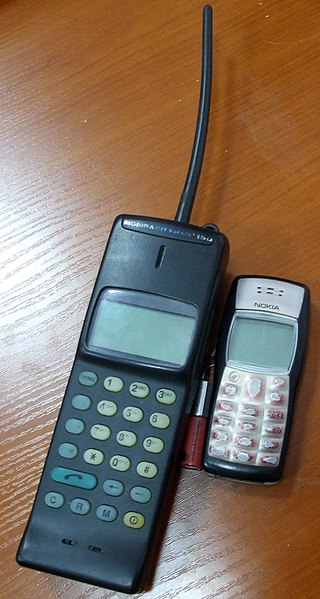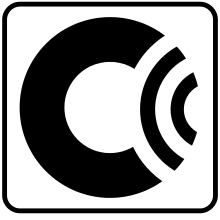
The Global System for Mobile Communications (GSM) is a standard developed by the European Telecommunications Standards Institute (ETSI) to describe the protocols for second-generation (2G) digital cellular networks used by mobile devices such as mobile phones and tablets. GSM is also a trade mark owned by the GSM Association. "GSM" may also refer to the voice codec initially used in GSM.
A personal communications service (PCS) is set of communications capabilities that provide a combination of terminal mobility, personal mobility, and service profile management. This class of services comprises several types of wireless voice or wireless data communications systems, typically incorporating digital technology, providing services similar to advanced cellular mobile or paging services. In addition, PCS can also be used to provide other wireless communications services, including services that allow people to place and receive communications while away from their home or office, as well as wireless communications to homes, office buildings and other fixed locations. Described in more commercial terms, PCS is a generation of wireless cellular-phone technology, that combines a range of features and services surpassing those available in analogue- and first-generation (2G) digital-cellular phone systems, providing a user with an all-in-one wireless phone, paging, messaging, and data service.
The Universal Mobile Telecommunications System (UMTS) is a 3G mobile cellular system for networks based on the GSM standard. Developed and maintained by the 3GPP, UMTS is a component of the International Telecommunication Union IMT-2000 standard set and compares with the CDMA2000 standard set for networks based on the competing cdmaOne technology. UMTS uses wideband code-division multiple access (W-CDMA) radio access technology to offer greater spectral efficiency and bandwidth to mobile network operators.

T-Mobile is the brand name used by some of the mobile communications subsidiaries of the German telecommunications company Deutsche Telekom AG in the Czech Republic, Poland and the United States.

Ultra high frequency (UHF) is the ITU designation for radio frequencies in the range between 300 megahertz (MHz) and 3 gigahertz (GHz), also known as the decimetre band as the wavelengths range from one meter to one tenth of a meter. Radio waves with frequencies above the UHF band fall into the super-high frequency (SHF) or microwave frequency range. Lower frequency signals fall into the VHF or lower bands. UHF radio waves propagate mainly by line of sight; they are blocked by hills and large buildings although the transmission through building walls is strong enough for indoor reception. They are used for television broadcasting, cell phones, satellite communication including GPS, personal radio services including Wi-Fi and Bluetooth, walkie-talkies, cordless phones, satellite phones, and numerous other applications.
2G, or second-generation cellular network technology, marks the transition from analog to digital communication in mobile networks. Defined by the European Telecommunications Standards Institute (ETSI) under the GSM standard, which became the first globally adopted framework for mobile communications, 2G was first commercially launched in 1991 by Radiolinja in Finland. Following its introduction, the earlier mobile wireless network systems were retroactively designated as 1G. 2G networks were primarily designed to support voice calls and Short Message Service (SMS), with later advancements such as General Packet Radio Service (GPRS) enabling basic data services, including email and limited internet access. Unlike 1G networks, which used analog radio signals, 2G networks utilized digital radio signals for communication between mobile devices and base stations. This transition to digital technology enabled the implementation of encryption for voice calls and data transmission, significantly improving the security of mobile communications while also increasing capacity and efficiency compared to earlier analog systems. 2G was succeeded by 3G technology, which provided higher data transfer rates and expanded mobile internet capabilities.

NMT is an automatic cellular phone system specified by Nordic telecommunications administrations (PTTs) and opened for service on 1 October 1981. NMT is based on analogue technology and two variants exist: NMT-450 and NMT-900. The numbers indicate the frequency bands used. NMT-900 was introduced in 1986 and carries more channels than the older NMT-450 network.
IS-54 and IS-136 are second-generation (2G) mobile phone systems, known as Digital AMPS (D-AMPS), and most often referred to as TDMA, are a further development of the North American 1G mobile system Advanced Mobile Phone System (AMPS). It was once prevalent throughout the Americas, particularly in the United States and Canada since the first commercial network was deployed in 1993. D-AMPS is considered end-of-life, and existing networks have mostly been replaced by GSM/GPRS or CDMA2000 technologies.

A cellular network or mobile network is a telecommunications network where the link to and from end nodes is wireless and the network is distributed over land areas called cells, each served by at least one fixed-location transceiver. These base stations provide the cell with the network coverage which can be used for transmission of voice, data, and other types of content. A cell typically uses a different set of frequencies from neighboring cells, to avoid interference and provide guaranteed service quality within each cell.

A car phone is a mobile radio telephone specifically designed for and fitted into an automobile. This service originated with the Bell System and was first used in St. Louis, Missouri, on June 17, 1946.
Rogers Wireless Inc. is a Canadian mobile network operator headquartered in Toronto, providing service nationally throughout Canada. It is a wholly owned subsidiary of Rogers Communications. The company had revenues of just under $15.1 billion in 2018. Rogers Wireless is the largest wireless carrier in Canada, with 13.7 million subscribers as of Q2 2023.
GSM frequency bands or frequency ranges are the cellular frequencies designated by the ITU for the operation of GSM mobile phones and other mobile devices.

Mobile radio telephone systems were mobile telephony systems that preceded modern cellular network technology. Since they were the predecessors of the first generation of cellular telephones, these systems are sometimes retroactively referred to as pre-cellular systems. Technologies used in pre-cellular systems included the Push-to-talk, Mobile Telephone Service (MTS), Improved Mobile Telephone Service (IMTS), and Advanced Mobile Telephone System (AMTS) systems. These early mobile telephone systems can be distinguished from earlier closed radiotelephone systems in that they were available as a commercial service that was part of the public switched telephone network, with their own telephone numbers, rather than part of a closed network such as a police radio or taxi dispatching system.

The history of mobile phones covers mobile communication devices that connect wirelessly to the public switched telephone network.

The first analog mobile radio telephone in Czechoslovakia was AMR, in Czech Automatizovaný městský radiotelefon.

Vodafone GmbH is a telecommunications operator in Germany owned by Vodafone Group Plc and headquartered in Düsseldorf. It provides mobile phone, LTE, 5G, cable internet, landlines, cable TV, and IPTV services. As of the third quarter of 2021, Vodafone GmbH has more than 31 million mobile customers in Germany, making it the third-largest provider of mobile phone services in Germany. The company's headquarters are in the suburb of Heerdt in Düsseldorf, with regional offices throughout Germany. Vodafone Germany's main competitors are 1&1 Mobilfunk, Telekom Deutschland and Telefónica Germany.

T-Mobile US, Inc. is an American wireless network operator headquartered in Bellevue, Washington. Its largest shareholder is Deutsche Telekom, a company that operates telecommunications networks in several other countries. T-Mobile is the second largest wireless carrier in the United States, with 127.5 million subscribers as of September 30, 2024.
Cellular frequencies are the sets of frequency ranges within the ultra high frequency band that have been assigned for cellular-compatible mobile devices, such as mobile phones, to connect to cellular networks. Most mobile networks worldwide use portions of the radio frequency spectrum, allocated to the mobile service, for the transmission and reception of their signals. The particular bands may also be shared with other radiocommunication services, e.g. broadcasting service, and fixed service operation.

Telekom Deutschland GmbH is a German telecommunications company owned by Deutsche Telekom. Telekom offers landline phone, broadband, IPTV and mobile telephony services. It took its current name after Deutsche Telekom's German consumer fixed-line unit T-Home was merged into T-Mobile Deutschland.















